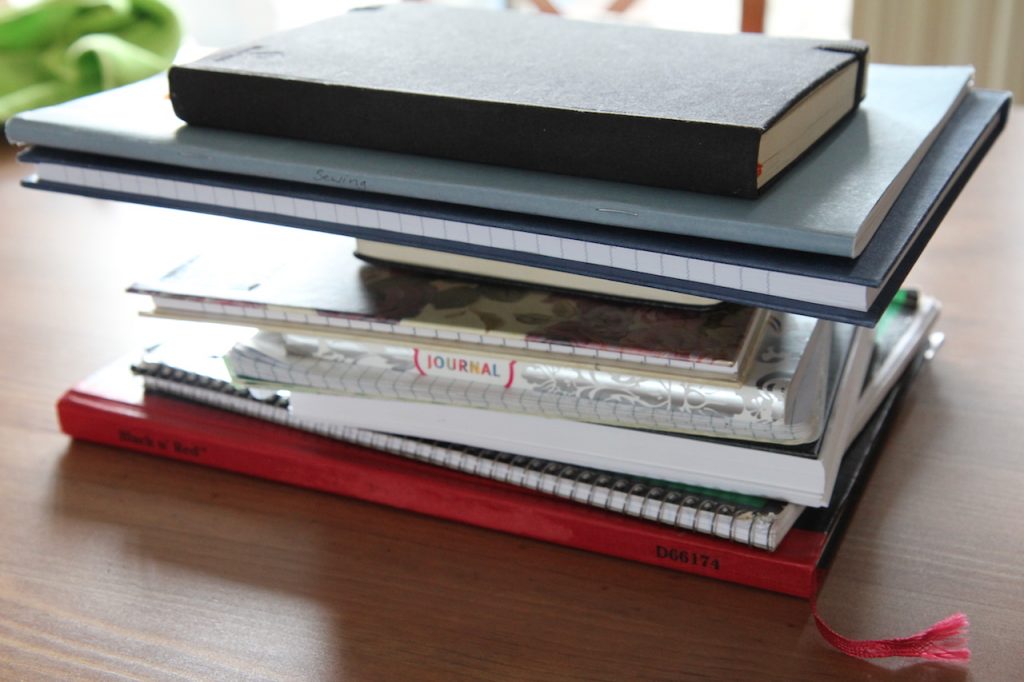The next Konmari category includes books and papers. I started with books.
Per the method, I pulled them off the shelves, and laid them out on the floor/table to go through one at a time. I followed Kondo’s four recommended divisions, but added a couple of my own to break things into logical groups:
Books for pleasure/fiction
Academic books
Other nonfiction
Art books
Magazines
Notebooks
Starting out, I tried a technique from Kondo’s second book, Spark Joy. If you’re having trouble identifying which items really bring you joy, she suggests taking 3 minutes to select your top 3 items from the category, and refer to these as benchmarks.
I tried this on my fiction/pleasure reading stack, and was surprised that despite feeling overwhelmed by the collection as a whole, it took me less than a minute to grab three books that I knew, instantly, were my favourites. If you’re interested, they were a copy of Sonnets from the Portuguese, a tiny, beautiful old copy of Emma, and The Complete Brambly Hedge. All are very different books, physically and generically, but I had no trouble selecting them and didn’t have to open the books at all. Later I spied a fourth that might have vied for a position among the favourites, Surprised by Joy. (The relevance of this title is not lost on me.)
For anyone struggling to identify what brings them joy, or just wondering what’s up with this joy business, I do recommend this exercise. Pick a category, and quickly grab your top 3 items. It gave me a very clear sensation of what Kondo means by joy: the feeling is visceral, delightful, and deep but instantaneous.
I did my academic books next, but I’m going to postpone that topic to the end, because it was the hardest category for me.
Less hard were miscellaneous nonfiction, art books, magazines, and notebooks.

But: academic books, you say. Academic books were harder. Certain ones give me that instantaneous joy: The Harley Lyrics. And I’m happy to say that so did the bound copy of my PhD thesis. But with other books I struggled with a surge of other strong thoughts and feelings that confused the issue:
I love the idea of having this book here to pick up one day when my brain is ready for it.
I have such happy memories of studying this book.
I love the annotations by the previous owner and it makes me feel like a part of something.
This is one of the books that made me pursue graduate study.
And, almost worst of all:
No one else will appreciate this book like I have.
It’s nice to imagine someone else excitedly snatching up my 1930s copy of Havelock the Dane in Goodwill after I donate it, but I suspect the chances of that are very small.
As Mike pointed out to me, having good thoughts about a book is not the same as the book itself sparking joy. He is quite right. So in many cases I was conflicted. I spent a lot of time handling books, enjoying fond memories. I took those old little editions of Latin classics and Middle English texts and felt their heft in my hand, inhaled that intoxicating library scent, admired the inky scrawl of mid-century students’ inscriptions, and cradled them in my palm as they fell obligingly open the way old books do.
What is the purpose of books? Why do they enter our lives and how do we know when their purpose is served? Is discarding books tantamount to discarding knowledge?
I am going to stop there for today, and leave my conclusion for tomorrow. I’ll tell you what I’m learning, and what I finally discarded.


I’m going to use this in my classroom to help students choose independent reading. Thank you for sharing!
That’s a great idea!